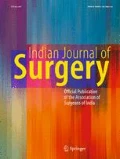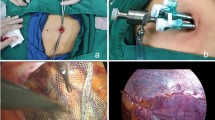Abstract
In inguinal hernia surgery, use of optimal mesh size during Lichtenstein hernioplasty technique is essential in preventing recurrence. This study was an attempt to determine a single optimal mesh size which can be adapted in vast majority of cases based on intraoperative inguinal measurements. This observational study was done for 1 year in the Department of Surgery, KLES Dr. Prabhakar Kore Hospital and Medical Research Centre, Belagavi, India. A total of 60 patients aged above 18 years who were scheduled for elective inguinal hernioplasty using the Lichtenstein technique for direct or indirect inguinal hernia were subjected to intraoperative measurements. All the patients were male with mean age of 52.75 ± 15.39 years. Mean body mass index (BMI) was 24.51 ± 3.10 kg/m2. With regard to hernia characteristics, most of the patients had right-sided hernia (61.7%), indirect (51.67%), and incomplete hernia (81.67%). The mean width of mesh required was 6.65 ± 0.24 cm and mean length was 13.75 ± 0.25 cm. The mesh size was comparable with respect to demographic characteristics, anthropometry, BMI, and type and extent of hernia (p > 0.050) but age and length of mesh size varied significantly in patients with direct and indirect type of hernia (p < 0.050). The present study made an attempt to determine a single optimal mesh size in cases who underwent inguinal hernia repair based on the principles of Lichtenstein hernioplasty, which being 6.7 cm × 13.8 cm. Another significant finding was varying in mesh length size between direct and indirect hernias.


Similar content being viewed by others
References
Jenkins JT, O’Dweyer PJ (2008) Inguinal hernias. BMJ 336(7638):269–272
Kingsnorth A, LeBlanc K (2003) Hernias: inguinal and incisional. Lancet 362:1561–1571
Gandhi D, Marcin S, Xin Z, Asha B, Kaswala D, Zamir B (2011) Chronic abdominal pain secondary to mesh erosion into cecum following incisional hernia repair: a case report and literature review. Ann Gastroenterol 24(4):321–324
Schumpelick V, Klinge U (2003) Prosthetic implants for hernia repair. Br J Surg 90:1457–1458
Burger JWA, Luijendijk RW, Hop WCJ, Halm JA, Verdaasdonk EGG, Jeekel J (2004) Long-term follow-up of RCT of suture versus mesh repair of incisional hernia. Ann Surg 240:578–585
Finan KR, Kilgore ML, Hawn MT (2009) Open suture versus mesh repair of primary incisional hernias a cost-utility analysis. Hernia 13:173–182
Mahmoud Uslu HY, Erkek AB, Cakmak A, Sozener U, Soylu L et al (2006) Incisional hernia treatment with polypropylene graft: results of 10 years. Hernia 10:380–384
Sauerland S, Schmedt CG, Lein S, Leibl BJ, Bittner R (2005) Primary incisional hernia repair with or without polypropylene mesh: a report on 384 patients with 5-year follow-up. Langenbeck's Arch Surg 390:408–412
Basu I, Bhoj SS, Mukhopadhyay AK (2013) Retrospective study on prevalence of primary and recurrent inguinal hernia and its repairs in patients admitted to a tertiary care hospital. Indian Med Gaz:203–213
Desarda MP, Why hernia re-occurs again and again. Frontiers. [internet] posted on: 24–06-2012. Available from: http://www.frontiersin.org/blog/%E2%80%9CWhy_hernia_re-occurs_again_and_again%E2%80%9D/46 Accessed 24 Oct 2013
Amid PK (2002) How to avoid recurrence in Lichtenstein tension-free hernioplasty. Am J Surg 184:259–260
William NS, Bulstrode CJK (2013) Abdominal wall, hernia and umbilicus. In: Olonnel PR (ed) Bailey and love’s short practice of surgery, 26th edn. CRC Press, Florida, pp 957–958
Fitzgibbons R Management of an inguinal hernia: conventional? Tension-free? Laparoscopic? or maybe no treatment at all. General Sessions of the American College of Surgeons. 86th Annual Clinical Congress 2000.
Rabe R, Yacapin CPR, Buckley BS, Faylona JM (2012) Repeated in vivo inguinal measurements to estimate a single optimal mesh size for inguinal herniorrhaphy. BMC Surg 12:19
The EU Hernia Trialists Collaboration (2002) Repair of groin hernia with synthetic mesh: meta-analysis of RCT. Ann Surg 235:322–332
Lomanto D, Cheah WK, Faylona JM, Huang CS, Lohsiriwat D, Maleachi A et al (2015) Inguinal hernia repair: toward Asian guidelines. Asian J Endosc Surg 8(1):16–23
Amid PK (2004) Lichtenstein tension-free hernioplasty: its inception, evolution, and principles. Hernia 8:1–7
Seker D, Oztuna D, Kulacoglu H, Genc Y, Akcil M (2013) Mesh size in Lichtenstein repair: a systematic review and meta-analysis to determine the importance of mesh size. Hernia 17:167–175
Amid PK (1997) Classification of biomaterials and their related complications in abdominal wall hernia surgery. Hernia 1:12–19
Klinge U, Klosterehalfen B, Muller M, Ottinger AP, Schumpelick V (1998) Shrinking of polypropylene mesh in vivo: an experimental study in dogs. Eur J Surg 164:965
Bringman S, Conze J, Cuccurullo D, Deprest J, Junge K, Klosterhalfen B et al (2010) Hernia repair: the search for ideal meshes. Hernia 14(1):81–87
Valenti G, Testa A, Capuano G (1998) Anthropometric measurements of the male inguinal canal. Minerva Chir 53(9):715–718
Nikolov S, Beltschev B (1990) Several ultrastructural peculiarities of the fascia transversalis in direct inguinal hernias of senile men. Anat Anz 170:265–272
Das S (2004) A manual on clinical surgery. 6th ed., Calcutta: Dr. S. Das
Gopal SV, Warrier A (2013) Recurrence after groin hernia repair-revisited. Int J Surg 11(5):374–377
Kux M (2002) Anatomy of the groin: a view from the surgeon. In: Nyhus and Condon’s Hernia. Fitzgibbons R, Greenberg G, eds. 5th ed. Philadelphia USA: Lippincott Williams and Wilkins p. 45.
Bay-Nielsen M, Nordin P, Nilsson E, Kehlet H, Base DHD, the Swedish Hernia Data Base (2001) Operative findings in recurrent hernia after a Lichtenstein procedure. Am J Surg 182:134–136
Author information
Authors and Affiliations
Corresponding author
Ethics declarations
The study was approved from the Institutional Ethical Committee, Jawaharlal Nehru Medical College, KLE University, Belagavi, India. The patients fulfilling selection criteria were informed about the purpose of this study and a written informed consent was obtained.
Conflict of Interest
The authors declare that they have no conflict of interest.
Rights and permissions
About this article
Cite this article
Abhishek, M.M., Pattanshetti, V.M. Intraoperative Inguinal Measurements to Estimate a Single Optimal Mesh Size for Lichtenstein Inguinal Hernioplasty: an Observational Study. Indian J Surg 80, 363–368 (2018). https://doi.org/10.1007/s12262-017-1612-4
Received:
Accepted:
Published:
Issue Date:
DOI: https://doi.org/10.1007/s12262-017-1612-4




